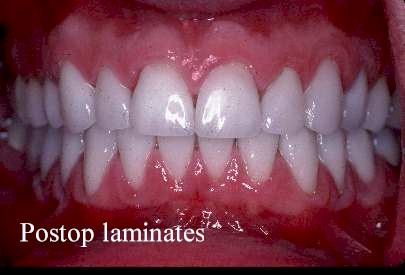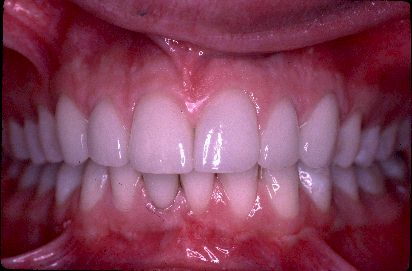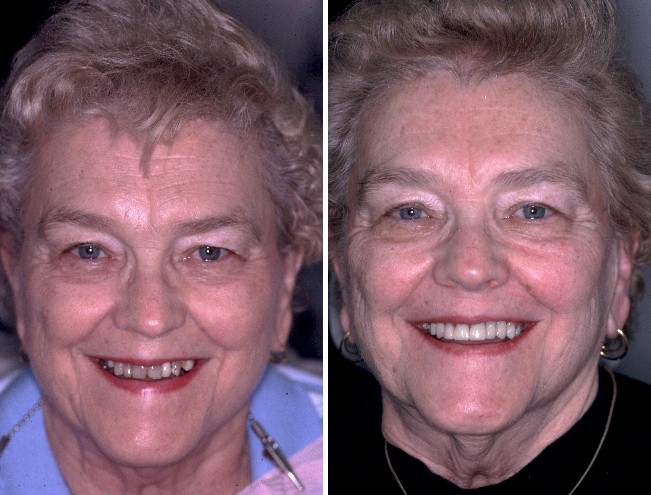Porcelain Restoration

This patient had moderate tetracycline staining of his teeth. He previously had porcelain laminates placed on his upper (maxillary) eight teeth. These laminates still appeared quite gray and "stubby". They created a look of old, worn teeth. In the postop photos you will notice not only whiter teeth, but also a younger appearance due to an increase in the length of his teeth.. . The new maxillary laminates create a more natural and esthetic form.

This patient is a model and had porcelain laminates done by another dentist. It is evident why she was not happy with her smile. Beside the color and staining, notice the difference in height of the two central incisors. Initially I recommended gingival surgery in order to even the height of the two central incisors, but she did not want to have surgery. So instead, using knowledge of tooth anatomy and contour we were able to create an esthetic form and color. We placed laminates on her six upper front teeth as well as her on lower right central incisor, which was discolored after a root canal treatment.
Notice in her smile picture how the teeth edges follow her lower lip symmetrically and how the gumline follows her upper lipline.
This is what creates an aesthetically pleasing and harmonious smile. The teeth appear vital and "Real".

This patient had a myriad of issues with her smile. Her main complaint was that she didn't like her smile. Her teeth were too dark, they were rotated and the old bondings were discolored. We staged her treatment. The first step was to do gum surgery in order to even the heights of her teeth. Then we bleached her teeth in order to lighten the overall shade. Next, we placed five porcelain laminates, the four center teeth (central and lateral incisors), as well as her left first premolar. The premolar is tucked into a shadow in her preoperative photograph. This type of combination approach frequently gives the best outcome. Each tooth needs to be individually assessed for its needs, then the entire smile needs to be evaluated in relationship to the lips and face.

In this case the patient's teeth were severely worn due to years of using a hard bristled tooth brush. He was tired of looking at the worn out teeth and he wanted a change. The two lateral incisors were not worn looking since they were porcelain crowns placed by a previous dentist. I chose to place two porcelain laminates and two all porcelain crowns(In-Ceram). This case demonstrates how different techniques need to be matched in order to get a good esthetic result. It also demonstrates how the face and lips are truly needed in order to assess overall esthetic harmony. In the postoperative photograph it appears that the teeth slant and get smaller and this seems odd, but when you see that the lip is asymmetrical, but symmetrical with the teeth, the final look is esthetic harmony.

This is an interesting case because these porcelain laminates were not constructed in a laboratory, but rather they were fabricated on a CEREC CAD/CAM milling machine, and in-office porcelain milling machine developed by Siemens. The front four teeth were laminated. This machine is mainly used for milling inlays and onlays, which have their own section on the website, although the newest CEREC II machine also has the ability to mill crowns.

This patient also had a combination approach taken. She had two crowns, three porcelain laminates and a removable partial denture fabricated in order to enhance her smile.

This 15 year old had fractured his two front teeth a few years earlier. His right central incisor had a root canal therapy completed at the time of the accident. His teeth had been bonded as an interim measure until the root development was completed. The bonding was now wearing out. We decided to repair the right central incisor with a porcelain laminate and bond the left central incisor with composite resin. You will easily notice the difference in these two materials. The laminate is shiny and smooth while the bonding is duller when dry. The final color matches are similar. The only change I would make in this case is to slightly reshape the inner corner of the bonding to be more symmetrical.

This patient had a very large amalgam filling removed after it cracked. There was not enough tooth remaining to place another filling. Either a crown or porcelain onlay would have been appropriate treatment. We chose the onlay due to its conservative nature. The final restoration can be seen on the right, just after it was completed. This restoration was done using the CEREC CAD/CAM method.

This patient had a premolar which had a large amalgam previously. The outer cusp fractured off to the gumline. We discussed placing a crown versus a porcelain onlay. The patient wished to try an onlay, since the chance of needing a root canal was less. An onlay was placed and the nerve in the tooth to this day is still alive and healthy. It has been three years.

This is the simplest porcelain filling I place. It consists of only a single surface. The change in esthetics is remarkable. Notice how the grayness of the amalgam actually makes the tooth itself appear gray. This happens because the mineral structure of the tooth is quite translucent and colors bleed through it similar to a lens over a light bulb. The grayness disappears in the postoperative photo.

Here is an example of the most common indication for an onlay and why I like to place them instead of large amalgams. When back teeth have large amalgams in them, they fracture at an alarming rate. When they fracture, they usually need either a crown or an onlay depending upon how much tooth is remaining and if the tooth can be kept dry during the insertion step. My preferred filling in a back tooth when more that 1/3 of the tooth's biting surface is destroyed is a bonded porcelain onlay. Studies have shown that these teeth, once restored have no more likelihood of fracturing than the original unrestored tooth.

Here is another example of a tooth that most doctors would have said needs a crown. The nerve was healthy and we decided to place an onlay rather than a crown in order to avoid an intentional root canal therapy (When a healthy nerve is removed in order to provide space for a post and core to support a crown). A very large onlay was placed and four years later the tooth is still intact with a living nerve. Notice the stains which can be placed on the onlay to mimic the natural stains on her teeth.

Here is another post amalgam fracture replaced with a bonded onlay.

Here is an amalgam replaced with an onlay prior to cuspal fracture.

Here is an interesting case where this woman had orthodontics in order to close a space (diastema) between her front two teeth. After the braces were removed she found that her teeth would spread apart again during the day, while her retainer was out. She had had a metal/composite resin splint made from the tongue side as can be seen in the preop photo, but this splint kept fracturing. So I decided to try splinting the teeth with a porcelain inlay which was bonded into the two teeth. This created not only a solid splint, but a much more esthetic result. This has been in place without incident for three years now.
Porcelain Inlays and Onlays are an extension of the Bonding. It consists of applying a preformed piece of porcelain to the tooth using a chemical agent which chemically and micromechanically adheres (bonds) the porcelain to the tooth. The bonding materials used are the same as in composite resin bonding. Porcelain Inlays and Onlays are my preferred restoration in posterior (back) teeth due to their fracture resistance, conservative nature and esthetics. The most common usage for them in my practice is when old amalgam (silver) fillings are in need of replacement due to cracking, recurrent decay or secondary to tooth fracture (50% of teeth with large posterior amalgams fracture in less than 10 years). Many dentists use composite resin posterior fillings today, but I still feel that porcelain is a more durable restoration. There a number of different porcelain systems on the market, many with adequate attributes. These systems include Injection molded ceramics like Empress or OPC, slip cast ceramics like In-Ceram or In-Ceram Spinnell, CAD/CAM systems like CEREC and Duret. The older ceramic systems were prone to premature failure due to crack propagation, but these newer systems seem to have eliminated this problem by adding Leucite or other materials which stop the crack propagation. The CEREC method in particular utilizes a ceramic call VMKII which actually matches the wear patterns of natural enamel, so in theory the opposing tooth will not wear out prematurely. Other ceramic systems are more abrasive than natural enamel and can cause premature wear. Porcelain Inlays and Onlays are frequently used instead of crowns (capping) when there is enough good tooth remaining to support them. They require much less tooth reduction than crowns. The longevity is equal to a crown, and the esthetics are hard to beat. Studies have shown that teeth restored with bonded Inlays and Onlays have the same fracture resistance and strength characteristics as natural, unrestored teeth.
Porcelain Laminates or Veneers are an extension of the Bonding. It consists of applying a preformed thin veneer of porcelain to the tooth using a chemical agent which chemically and micromechanically adheres (bonds) the porcelain to the tooth. The bonding materials used are the same as in composite resin bonding.
The differences between porcelain veneering and composite resin veneering are:
1. Porcelain gives a more durable and aesthetic final result.
2. Porcelain requires at least two visits while composite resins are applied in one visit.
3. Porcelain laminates frequently are used instead of crowns (capping) when there is enough good tooth remaining to support them. They require much less tooth reduction than crowns.
When used properly, porcelain laminates can produce incredible results while providing a relatively conservative approach. Porcelain laminates can create illusions of color, form, and position easily.
When special porcelains called "luminaries" are applied within them, they can brighten dark teeth without creating an opaqueness. Luminaries are porcelains which produce visible light when they absorb ultraviolet light. They almost create an illusion of a flashlight inside the tooth. When trying to mask out a dark stain like tetracycline or root canal treated teeth, they are an ideal solution.
Laminates can create the illusion of straight teeth without orthodontics for the patient who does not want to be in braces. They can also change the color of teeth when other techniques fail.















